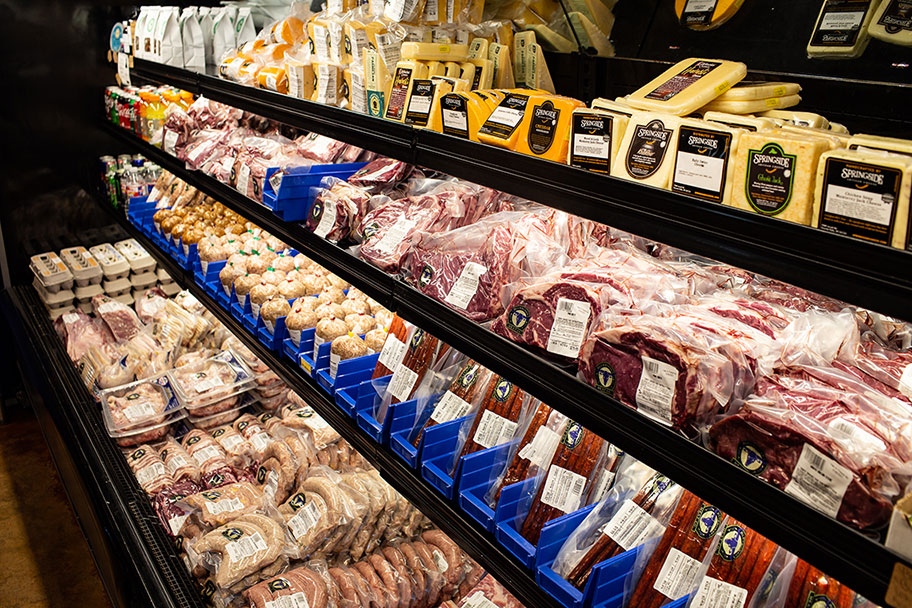Unlock the Tricks of High Quality Meat Choice at the Nearest Market
When it pertains to choosing high quality meat at the closest market, there are different elements to think about that can substantially affect the taste and overall experience of your meal. From understanding the intricacies of meat grading systems to identifying quality, marbling, and optimum cuts for various recipes, the procedure of picking the very best meat can appear like a complicated job. Nevertheless, by delving deeper right into the resource and production of the meat, along with finding out useful suggestions for proper storage space and handling, you can raise your culinary abilities and produce extraordinary dishes that will certainly leave your taste desiring extra.
Comprehending Meat Grading Systems
Comprehending meat grading systems is essential for customers seeking high-quality cuts of meat. Meat grading is a voluntary procedure that evaluates the high quality and uniformity of meat based upon factors such as marbling, shade, and maturity. The USA Division of Farming (USDA) is responsible for managing meat grading to make certain that consumers receive precise info about the meat they purchase.
There are two primary meat grading requirements made use of in the USA: quality grades and yield grades. Quality grades evaluate the flavor, tenderness, and juiciness of the meat, with USDA Prime being the greatest high quality grade, adhered to on purpose and Select. bagley meat market edwardsville il. On the various other hand, return grades concentrate on the quantity of usable meat obtained from a carcass, ranging from Grade 1 (high yield) to Quality 5 (reduced return)
Recognizing Quality and Marbling

After gaining an understanding of meat grading systems, customers can currently transform their attention to recognizing freshness and marbling in the meat they pick at the market. Freshness is an essential variable when choosing top quality meat.
When picking meat, look for well-marbled cuts to guarantee a much more flavorful and tender dining experience. By paying interest to quality and marbling, consumers can make informed decisions and appreciate top quality meat items.
Optimum Cuts for Various Dishes
When thinking about optimum cuts for various dishes, it is important to match the features of the meat to the food preparation approach and recipe demands. For recipes that require long, slow cooking like braises or stews, harder cuts with more connective tissue, such as chuck or brisket, are suitable. These cuts damage down during cooking, causing tender, savory dishes. In contrast, for quick-cooking methods like grilling or pan-searing, lean and tender cuts like tenderloin or sirloin are preferred to stop durability.
Ground meat from chuck or round is outstanding for dishes like meatballs or burgers, giving an excellent equilibrium of fat and flavor. When making roasts, such as a prime rib or pork loin, lean cuts with a layer of fat on the outdoors assistance keep the meat wet and tender throughout cooking.
Knowing the Resource and Manufacturing

Sourcing meat properly and recognizing its manufacturing process are important actions in ensuring the quality and stability of the final item. By picking meat from reliable sources, consumers can have a lot more self-confidence in the top quality and safety and security of the product they are purchasing.
Understanding the production process of meat is similarly crucial (bagley meat market edwardsville il). Customers need to be mindful of just how the pets were elevated, what they were fed, and whether any kind of hormonal agents or antibiotics were used during the rearing process. This information not just influences the quality of the meat but directory also has implications for animal well-being and ecological sustainability
Tips for Correct Storage Space and Handling
For ideal high quality and security of meat products, proper storage space and taking care of strategies are crucial. When saving meat, it is critical to maintain it at the ideal temperature. Refrigerate fresh meat at temperature levels listed below 40 ° F(4 ° C) to reduce microbial growth and keep freshness. It is recommended to store raw meat in its initial look here product packaging on the bottom shelf of the fridge to stop juices from leaking onto other foods.
To prolong the shelf life of meat, take into consideration freezing it. For ideal results, wrap the meat securely in plastic wrap or light weight aluminum foil before positioning it in a closed container or fridge freezer bag. Tag the browse around here bundles with the day to track freshness. Defrost frozen meat in the fridge or using the defrost setup on the microwave to stop microbial growth.
When managing meat, constantly wash your hands, tools, and surface areas with hot, soapy water prior to and after call to avoid cross-contamination. Usage different cutting boards for meat and other foods, and cook meat to the advised internal temperature level to ensure it is risk-free to consume. By adhering to these storage and managing pointers, you can maintain the high quality and safety and security of your meat products.
Final Thought
In verdict, mastering the art of choosing top quality meat entails comprehending grading systems, determining quality and marbling, choosing optimal cuts for different meals, and understanding the resource and manufacturing approaches. Proper storage and handling are likewise vital to keeping the quality of your meat - bagley meat market edwardsville il. By following these guidelines, you can guarantee that you are choosing the finest meat offered at your nearby market
From recognizing the details of meat grading systems to identifying quality, marbling, and optimum cuts for various recipes, the procedure of picking the ideal meat can appear like a daunting task.Understanding meat grading systems is important for consumers seeking top quality cuts of meat. Meat grading is a voluntary process that evaluates the quality and consistency of meat based on factors such as shade, maturation, and marbling. The United States Division of Agriculture (USDA) is responsible for overseeing meat grading to make certain that customers get precise information about the meat they acquire.
